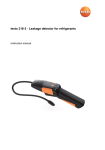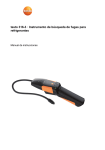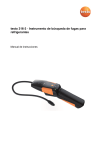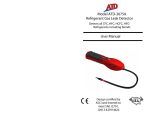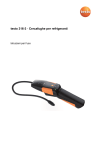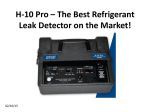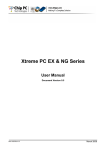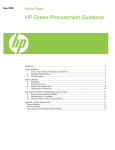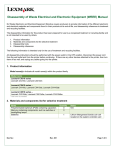Download Manuals - OMEGA Engineering
Transcript
User’s Guide Shop online at omega.com SM e-mail: [email protected] For latest product manuals: www.omegamanual.info HHLT-2 Refrigerant Leak Detector With Pump omega.com [email protected] U.S.A.: Servicing North America: Omega Engineering, Inc., One Omega Drive, P.O. Box 4047 Stamford, CT 06907-0047 USA Toll-Free: 1-800-826-6342 (USA & Canada only) Customer Service: 1-800-622-2378 (USA & Canada only) Engineering Service: 1-800-872-9436 (USA & Canada only) Tel: (203) 359-1660 Fax: (203) 359-7700 e-mail: [email protected] For Other Locations Visit omega.com/worldwide The information contained in this document is believed to be correct, but OMEGA accepts no liability for any errors it contains, and reserves the right to alter specifications without notice. TABLE OF CONTENTS Introduction . . . . . . . . . . . . . . . . . . . . . . . . . . . . . . . . . . . . . . . . . . . . . 2 – 4 How It Works . . . . . . . . . . . . . . . . . . . . . . . . . . . . . . . . . . . . . . . . 3 – 4 Key Features . . . . . . . . . . . . . . . . . . . . . . . . . . . . . . . . . . . . . . . . . . . . . . . . 4 What’s in the Case . . . . . . . . . . . . . . . . . . . . . . . . . . . . . . . . . . . . . . . . . . . 5 Setup Instructions. . . . . . . . . . . . . . . . . . . . . . . . . . . . . . . . . . . . . . . . . . . . 5 Install Batteries . . . . . . . . . . . . . . . . . . . . . . . . . . . . . . . . . . . . . . . . . 5 Operating Instructions . . . . . . . . . . . . . . . . . . . . . . . . . . . . . . . . . . . . . 5 – 8 Starting Up . . . . . . . . . . . . . . . . . . . . . . . . . . . . . . . . . . . . . . . . . 5 – 6 Checking for Leaks . . . . . . . . . . . . . . . . . . . . . . . . . . . . . . . . . . . 6 – 7 Using the Leak Test Vial. . . . . . . . . . . . . . . . . . . . . . . . . . . . . . . . . . . 8 Specifications . . . . . . . . . . . . . . . . . . . . . . . . . . . . . . . . . . . . . . . . . . . . . . . 9 Maintenance Instructions . . . . . . . . . . . . . . . . . . . . . . . . . . . . . . . . . . . . . . 9 Changing the Batteries . . . . . . . . . . . . . . . . . . . . . . . . . . . . . . . . . . . 9 Replacing the Filter . . . . . . . . . . . . . . . . . . . . . . . . . . . . . . . . . . . . . . 9 Warranty Information . . . . . . . . . . . . . . . . . . . . . . . . . . . . . . . . . . . . . . . . 10 Return for Repair Policy . . . . . . . . . . . . . . . . . . . . . . . . . . . . . . . . . . . . . . 10 INTRODUCTION Thank you for purchasing OMEGA’s HHLT-2 Digital Refrigerant Leak Detector with Pump. Please read this user’s manual carefully and thoroughly before using the product. The HHLT-2’s long-lasting solid electrolyte semiconductor sensor can detect leaks of all halogenated (chlorine or fluorine-based) refrigerant gases currently in common use. They include HFCs (hydrofluorocarbons), CFCs (chlorofluorocarbons) and HCFCs (hydrochlorofluorocarbons). Specifically, the instrument can detect: • Widely used HFC refrigerants such as R-134a, R-410a, R-404a, R-407c and R-507 • CFC refrigerants such as CFC-12 (R-12)—commonly known as Freon • HCFC replacement blends, such as R-22, approved by the U.S. EPA for complying with the stratospheric ozone protection provisions of the Clean Air Act • R-1234yf, the newly approved hydrofluoroolefin (HFO) refrigerant with a global warming potential 335 times less than that of R-134a Electronic sensing is the most widely used, sensitive and accurate method of refrigerant leak detection. 2 WHY LOOK FOR REFRIGERANT LEAKS? There are three reasons to detect and repair leaks of refrigerant gases from stationary and mobile air conditioners, refrigeration systems and heat pumps: 1. Leaks allow air and moisture to enter an A/C system or chiller. Moisture can react with refrigerant to form corrosive acids and sludge that can damage a compressor, plug up orifice tubes, and/or eat pinholes in evaporators and condensers. 2. Refrigerant is expensive. It may seem cheaper to keep recharging your system with refrigerant than fix a leak—but it isn’t in the long run. And A/C systems and chillers that aren’t fully charged won’t cool efficiently and thus waste money (electricity-powered systems) or fuel (vehicle systems). 3. Most refrigerants deplete the ozone layer that blocks the Sun's harmful ultraviolet radiation. In the U.S., the Clean Air Act of 1990 and later amendments require owners or operators of refrigeration and airconditioning equipment with refrigerant charges greater than 50 pounds to repair leaks within 30 days when those leaks result in the loss of more than 15% (comfort cooling) or 35% (commercial cooling) of the charge over a 12-month period. The HHLT-2’s proprietary sensor and detection technology are the keys to its excellent performance and durability. Compared to products of decades past with “heated sensors”, the HHLT-2 warms its sensor to a much lower temperature. The reduction in heat reduces the instrument’s power consumption and improves sensor stability while extending the life of the sensor and maintaining its electrochemical function. Test data indicate no decline in the sensor’s performance after thousands of hours of operation. Sensor life is specified at more than ten years of normal use. In addition, because the instrument and sensor comply with SAE Standards J2791 and J2913 and the European Standard EN14624, the sensor will not be damaged by overexposure to refrigerant gas or by contamination by water. To comply with SAE J2791, the HHLT-2 also had to demonstrate its sensitivity to 15 different chemicals and pass two “garage durability” tests, one requiring it to survive three drops from 4 ft. onto concrete. HOW IT WORKS A small mechanical pump inside the HHLT-2 draws a sample of air through the tip of the instrument’s 17-in. long probe into a proprietary sensor 1-1/2 inches downstream. A proportional halogen detector in the sensor determines whether any refrigerant gas is in the sample. If any gas is detected, the sensor and other circuits measure the amount of refrigerant and convert the value to an electrical signal. If no leak is detected, no signal is produced and the display remains off (dark). When a leak is detected, the signal is amplified, digitized, and displayed on the front panel as a large, bright red number from 1 to 9 corresponding to the size of the leak (1 for the smallest leaks, 9 for the largest). 3 The digital readout makes it easy to pinpoint the source of a leak and helps you decide whether it is large enough to be worth plugging. The reading is independent of the selected sensitivity level (three are available) and is at its highest when the tip of the probe is at the source of the leak. A table in the Operating Instructions section of this manual correlates display readings with leak size, in ounces per year. The HHLT-2 simultaneously uses sound to help locate the source of a leak. Whenever the unit is on, it continuously produces three very loud beeps every two seconds. When a leak is detected, the frequency of the beeping increases dramatically. The beeper can be muted by pressing a dedicated button on the front panel. A third feature of the HHLT-2 that helps locate leaks is a red LED adjacent to the sensor at the end of the probe. This light flashes in sync with the beep. In other words, it flashes three times every two seconds whenever the unit is on, and much faster whenever the unit detects refrigerant. When the red LED begins to flash rapidly, your eye will naturally be drawn to it—and therefore the location of the leak. Like the leak-size readout, the LED at the end of the probe is bright enough to be visible in full sunlight. The HHLT-2 automatically compensates for ambient levels of refrigerant gas. No manual sensitivity adjustments or power adjustments are required. The instrument is supplied with a proprietary leak test vial that lets you verify that it is working properly prior to searching for a leak. The HHLT-2 is powered by four “AA” batteries, which are included in the case. KEY FEATURES • Proprietary sensor with lifetime of thousands of hours of operation (ten years of normal use) • Detects all commercially available HFC, HFO, HC, HCFC and CFC refrigerants as well as blends and newly approved replacements such as R-22 and R-1234yf • Triple-redundant leak indication (loud fast beep, bright flashing LED, digital leak size reading) • True mechanical pump draws in samples, increasing sensitivity • Sensitivity of 0.05 oz./year (1.4 g/year) to R-134a • Three sensitivity levels • Fast warmup • Comfortable neoprene grip • Automatic calibration and reset to ambient levels • Mutable beeper • Garage-durable construction • Leak test vial • Low battery indicator • Padded hard plastic case • Made in U.S.A. • SAE J2791 and J2913 certified • 2-year warranty includes sensor • CE, RoHS, WEEE approved • Complies with European standard EN 14624 4 WHAT’S IN THE CASE The HHLT-2 comes fully assembled in a padded hard plastic carrying case. Also in the case are a leak test vial (for checking that the unit is performing properly), a pack of four “AA” batteries, five spare sensor filters and this user’s manual. SETUP INSTRUCTIONS INSTALL BATTERIES To install the four included “AA” batteries, Polarity Marks use a Phillips-head screwdriver to open the hinged door of the two-sided battery compartment at the bottom of the HHLT-2. Insert two batteries in the right side of the compartment (+) end first, and the other two in the left compartment (-) end first. To help you do this correctly, there are (+) and (-) polarity marks on the hinged door (see figure at right). Be sure each mark ends up next to the corresponding terminal of a battery. OPERATING INSTRUCTIONS All of the HHLT-2’s controls and Digital leak size indicators are on the front panel. indicator Familiarize yourself with the names and positions of the controls and indicators shown below before moving on to the Low battery indicator (red LED) Setup Instructions and Operating Instructions. STARTING UP Sensitivity level LEDs (yellow, green, red) Before the HHLT-2 can be used to detect refrigerant leaks, it must execute the following three-step startup sequence: Beeper mute and sensitivity buttons 1) TURN ON. Press the button to power on the unit. Power on/off button 2) WARM UP. Once the unit has been powered on, it will automatically begin heating the sensor. During warmup, 1) the digital leak size indicator flashes “0”; 2) the yellow, red and green sensitivity LEDs illuminate in sequence; and 3) the beeper sounds repeatedly at a rate of three beeps every two seconds. To silence the beep, press the Mute button. The warmup cycle normally takes 17–20 seconds. 3) READY. The HHLT-2 is ready to search for leaks when: 1) the display stops flashing “0” and goes dark; 2) the green LED indicating NORM sensitivity (the default level) lights up; and 3) you hear and feel the internal pump start up. 5 IMPORTANT: The startup sequence will not execute to completion if the refrigerant gas sensor cannot be heated. That would be the case if the sensor becomes electrically disconnected from the probe. The sensor (which is under the black probe tip assembly) is physically and electrically connected to the probe by a six-pin socket visible under the clear plastic near the red “refrigerant detected” LED near the end of the probe (see figure below). If the startup sequence fails to complete after 60 seconds, abort the process by powering off the unit. Then check the integrity of the connection between the sensor and the probe by doing the following: 1) Pull the black probe tip assembly straight out and away from the sensor socket without twisting it. This disconnects the sensor. 2) Line up the keyway notch on the probe tip assembly with the raised keyway on the sensor socket holder 3) Carefully push the sensor back into the socket without forcing or twisting it; misalignment can damage the sensor’s pins. This reconnects the sensor. Sensor socket and red “refrigerant detected” LED CHECKING FOR LEAKS Position the end of the HHLT-2’s flexible-obedient probe—which retains its configured shape—close to any suspected source of leaking refrigerant gas. In a vehicle, wet oily areas around hose connections and fittings, and greasy streaks radiating outward around the compressor clutch or on the underside of the hood just above the compressor are telltale signs of a leak. Another place to check sooner rather than later is the evaporator (located inside the heater/defroster plenum under the dash). Whenever the sensor at the end of the probe senses a refrigerant gas that it has been designed to detect: 1) The red LED at the end of the probe will begin flashing much faster than three times every two seconds 2) The beeper will increase its own frequency correspondingly 3) A number from 1 to 9 will appear in the digital leak size indicator window. 6 The reading reflects the concentration of refrigerant gas sensed. The maximum value will be displayed when the tip of the probe is at the source of the leak. Try switching between different sensitivity levels while moving the probe until the highest number appears. To raise the sensitivity level, press the SENS. button once; this will light the red LED labeled HI. To lower the sensitivity level, press the SENS. button again; this will light the yellow LED labeled LO. The table below can be used to approximate the size of a leak. Maximum Value Displayed 1 to 3 4 to 6 7 to 9 Leak Size (oz./yr) < 0.1 0.1 to 0.5 >0.5 Note re: Cross sensitivity to automotive chemicals Some automotive solvents and chemicals have hydrocarbon properties similar to R134a and therefore may produce a non-zero reading on the digital leak detector. Before checking for refrigerant leaks, clean up any chemicals in the list below, which may produce a positive response. Brand/type Rain-X windshield washer fluid Ford spot remover (wet) Ford rust inhibitor Ford gasket adhesive (wet) Loctite Natural Blue degreaser (diluted) Ford brake parts cleaner Ford silicone rubber (uncured) Motorcraft antifreeze heated to 160°F Gunk liquid wrench Ford pumice lotion (with solvent) Ford Motorcraft brake fluid Ford carburetor cleaner Response Y Y Y Y Y Y Y Y Y Y Y Y 7 USING THE LEAK TEST VIAL The HHLT-2 ships with a leak test vial that lets you check whether the instrument is working properly. To perform this check: 1) Remove the leak test vial from its Ziploc plastic bag and remove the black rubber cap from the top of the vial. The cap pops off, rather than unscrews (see figure below). The first time you use the vial, you must remove and discard the circular insert under the black plastic screw-on cap with pinhole. 2) Power on the HHLT-2 and wait for it to complete the three-step startup sequence. Black rubber cap (remove 3) Position the tip of the probe at the pinhole in the top of to test) the vial’s screw-on cap. If the HHLT-2 is working Black plastic properly, the beep rate and the flashing frequency of the screw-on cap red LED near the probe tip will increase dramatically. A with pinhole number between 4 and 6 should (DO NOT remove to test) appear on the digital leak size indicator if you are using the vial included with the unit. Glass leak test vial 4) Put the black rubber cap back over the vial’s screw-on cap. If you do not, the contents of the vial will evaporate over time. NOTE: If the above check does not produce a non-zero reading, either your leak test vial is empty or your HHLT-2 is defective. If the bottom of your leak test vial does not appear green, replace the vial. To locate a replacement, search the Internet for “Refrigerant leak detector reference”. If a full leak test vial does not produce a non-zero reading, it is likely that your HHLT-2 is defective (or requires a new sensor). General will repair or replace your unit (or its sensor) if you purchased it within the past two years and have complied with the terms of the HHLT-2’s limited warranty. Contact our Customer Service department at 800-872-9436 to obtain a Return Goods Authorization (RGA) number before shipping the unit. 8 SPECIFICATIONS Refrigerants Detected R-134a, R-410a, R-404a, R-407c, R-507, CFC-12 (R-12 or Freon), R-22, R-1234yf Detection Modalities Sound, light, leak size measure Sensitivities 0.05 oz./yr (1.4 g/yr) for R-134a; 0.025 oz./yr (0.7g/yr) for R-22 Sensor Type Proprietary solid electrolyte semiconductor Sensor Life >300 hours (ten years’ normal use) Warmup Time 17–20 seconds Response Time Instantaneous Display Type, Size 7-segment red LED, 0.6 in. (15mm) high Dimensions of Instrument 6.8 x 2.6 x 2.2 in. (173 x 66 x 56mm) w/17 in. (432mm) probe Weight of Instrument 1.5 lb. (680g) Dimensions of Carrying Case 15 x 11 x 4 in. (382 x 279 x 102mm) Weight of Instrument, 2 lbs, 5.5 oz. (1.06kg) Batteries and Carrying Case Complies with SAE Standards J2791 and J2913, European Standard EN14624 Limited Warranty Term 2 years (including sensor) Power Source 4 “AA” batteries (included) Battery Life 5 hours continuous operation (typical) MAINTENANCE INSTRUCTIONS CHANGING BATTERIES When the red front-panel LED labeled Low Battery lights up, it’s time to replace the instrument’s four “AA” batteries. To do so, follow the procedure in the Setup Instructions section of this manual. CHANGING THE FILTER The HHLT-2 ships with a pack of five small disc filters that install upstream of the sensor. Replace the filter whenever it becomes visibly dirty, or every few months, depending on use. To change the filter, unscrew the black plastic tip of the probe from the black plastic sensor enclosure (see figure on p. 6.) Remove the old filter, install the new one, and then screw the plastic tip back into the enclosure. 9 NOTES ________________________________________________________________ ________________________________________________________________ ________________________________________________________________ ________________________________________________________________ ________________________________________________________________ ________________________________________________________________ ________________________________________________________________ ________________________________________________________________ ________________________________________________________________ ________________________________________________________________ ________________________________________________________________ ________________________________________________________________ ________________________________________________________________ ________________________________________________________________ ________________________________________________________________ ________________________________________________________________ ________________________________________________________________ ________________________________________________________________ ________________________________________________________________ ________________________________________________________________ ________________________________________________________________ ________________________________________________________________ ________________________________________________________________ ________________________________________________________________ 10 WARRANTY/DISCLAIMER OMEGA ENGINEERING, INC. warrants this unit to be free of defects in materials and workmanship for a period of 13 months from date of purchase. OMEGA’s WARRANTY adds an additional one (1) month grace period to the normal one (1) year product warranty to cover handling and shipping time. This ensures that OMEGA’s customers receive maximum coverage on each product. If the unit malfunctions, it must be returned to the factory for evaluation. OMEGA’s Customer Service Department will issue an Authorized Return (AR) number immediately upon phone or written request. Upon examination by OMEGA, if the unit is found to be defective, it will be repaired or replaced at no charge. OMEGA’s WARRANTY does not apply to defects resulting from any action of the purchaser, including but not limited to mishandling, improper interfacing, operation outside of design limits, improper repair, or unauthorized modification. This WARRANTY is VOID if the unit shows evidence of having been tampered with or shows evidence of having been damaged as a result of excessive corrosion; or current, heat, moisture or vibration; improper specification; misapplication; misuse or other operating conditions outside of OMEGA’s control. Components in which wear is not warranted, include but are not limited to contact points, fuses, and triacs. OMEGA is pleased to offer suggestions on the use of its various products. However, OMEGA neither assumes responsibility for any omissions or errors nor assumes liability for any damages that result from the use of its products in accordance with information provided by OMEGA, either verbal or written. OMEGA warrants only that the parts manufactured by the company will be as specified and free of defects. OMEGA MAKES NO OTHER WARRANTIES OR REPRESENTATIONS OF ANY KIND WHATSOEVER, EXPRESSED OR IMPLIED, EXCEPT THAT OF TITLE, AND ALL IMPLIED WARRANTIES INCLUDING ANY WARRANTY OF MERCHANTABILITY AND FITNESS FOR A PARTICULAR PURPOSE ARE HEREBY DISCLAIMED. LIMITATION OF LIABILITY: The remedies of purchaser set forth herein are exclusive, and the total liability of OMEGA with respect to this order, whether based on contract, warranty, negligence, indemnification, strict liability or otherwise, shall not exceed the purchase price of the component upon which liability is based. In no event shall OMEGA be liable for consequential, incidental or special damages. CONDITIONS: Equipment sold by OMEGA is not intended to be used, nor shall it be used: (1) as a “Basic Component” under 10 CFR 21 (NRC), used in or with any nuclear installation or activity; or (2) in medical applications or used on humans. Should any Product(s) be used in or with any nuclear installation or activity, medical application, used on humans, or misused in any way, OMEGA assumes no responsibility as set forth in our basic WARRANTY / DISCLAIMER language, and, additionally, purchaser will indemnify OMEGA and hold OMEGA harmless from any liability or damage whatsoever arising out of the use of the Product(s) in such a manner. RETURN REQUESTS/INQUIRIES Direct all warranty and repair requests/inquiries to the OMEGA Customer Service Department. BEFORE RETURNING ANY PRODUCT(S) TO OMEGA, PURCHASER MUST OBTAIN AN AUTHORIZED RETURN (AR) NUMBER FROM OMEGA’S CUSTOMER SERVICE DEPARTMENT (IN ORDER TO AVOID PROCESSING DELAYS). The assigned AR number should then be marked on the outside of the return package and on any correspondence. The purchaser is responsible for shipping charges, freight, insurance and proper packaging to prevent breakage in transit. FOR WARRANTY RETURNS, please have the following information available BEFORE contacting OMEGA: 1. Purchase Order number under which the product was PURCHASED, 2. Model and serial number of the product under warranty, and 3. Repair instructions and/or specific problems relative to the product. FOR NON-WARRANTY REPAIRS, consult OMEGA for current repair charges. Have the following information available BEFORE contacting OMEGA: 1. Purchase Order number to cover the COST of the repair, 2. Model and serial number of the product, and 3. Repair instructions and/or specific problems relative to the product. OMEGA’s policy is to make running changes, not model changes, whenever an improvement is possible. This affords our customers the latest in technology and engineering. OMEGA is a registered trademark of OMEGA ENGINEERING, INC. © Copyright 2015 OMEGA ENGINEERING, INC. All rights reserved. This document may not be copied, photocopied, reproduced, translated, or reduced to any electronic medium or machine-readable form, in whole or in part, without the prior written consent of OMEGA ENGINEERING, INC. Where Do I Find Everything I Need for Process Measurement and Control? OMEGA…Of Course! Shop online at omega.com SM TEMPERATURE M U M U M U M U M U Thermocouple, RTD & Thermistor Probes, Connectors, Panels & Assemblies Wire: Thermocouple, RTD & Thermistor Calibrators & Ice Point References Recorders, Controllers & Process Monitors Infrared Pyrometers PRESSURE, STRAIN AND FORCE M U M U M U M U Transducers & Strain Gages Load Cells & Pressure Gages Displacement Transducers Instrumentation & Accessories FLOW/LEVEL M U M U M U M U Rotameters, Gas Mass Flowmeters & Flow Computers Air Velocity Indicators Turbine/Paddlewheel Systems Totalizers & Batch Controllers pH/CONDUCTIVITY M U M U M U M U pH Electrodes, Testers & Accessories Benchtop/Laboratory Meters Controllers, Calibrators, Simulators & Pumps Industrial pH & Conductivity Equipment DATA ACQUISITION M U M U M U M U M U Data Acquisition & Engineering Software Communications-Based Acquisition Systems Plug-in Cards for Apple, IBM & Compatibles Data Logging Systems Recorders, Printers & Plotters HEATERS M U M U M U M U M U Heating Cable Cartridge & Strip Heaters Immersion & Band Heaters Flexible Heaters Laboratory Heaters ENVIRONMENTAL MONITORING AND CONTROL M U M U M U M U M U M U Metering & Control Instrumentation Refractometers Pumps & Tubing Air, Soil & Water Monitors Industrial Water & Wastewater Treatment pH, Conductivity & Dissolved Oxygen Instruments M5454/0315














